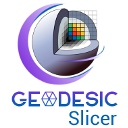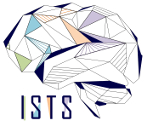Documentation/4.8/Modules/GeodesicSlicer
|
For the latest Slicer documentation, visit the read-the-docs. |
Introduction and Acknowledgements
|
The module has been developed based on ideas and feedback from the community. We would like to especially thank:
- Dr. Olivier Etard, M.D., Ph.D., CHU de Caen.
- Dr. Sonia Dollfus, M.D., Ph.D., CHU de Caen, header of ISTS.
- Dr. Csaba Pinter, MSc, Queen's University.
- Dr. Andras Lasso, Ph.D., Queen's University.
Contents
Module Description
This module calculates geodesic path in 3D structure. Thanks to this geodesic path, this module could draw an EEG 10-20 system.
Terminology
- Mesh A mesh or polygon mesh is a collection of vertices, edges and faces that defines the shape of a polyhedral object in 3D computer graphics and solid modeling.
- Shortest path In graph theory, the shortest path problem is the problem of finding a path between two vertices (or nodes) in a graph such that the sum of the weights of its constituent edges is minimized.
- 10-20 EEG system The International 10-20 system (Jasper 1958) is commonly used for EEG electrode placement and for correlating external skull locations to underlying cortical areas.
Use Cases
The overall goal is to allow users to find the shortest paths between nodes in a graph and via the Dijkstra's algorithm to make 10-20 system. This module can be used for:
- Stimulation in psychiatry
- surgery measurement
- 3D printing
Panels and their use
Image à insérer: "wiki_main_picture.png"
Create a mesh
Image à insérer: "wiki_main_picture2.png"
A typical straightforward Geodesic Slicer workflow for consists of the following steps:
- Load a volume.nii.
- Enter the Geodesic Slicer module using either the toolbar or the Modules menu button.
- Create a mesh.
- Wait a moment
- Use this mesh.
- If your background was named 't1' the label will be called 't1-label'.
- Go to Parameters to find the shortest path or Make 10-20 EEG system electrode section.
Parameters to find the shortest path
- Source points.
- Input STL model.
- Calculate in centimeter the shortest path via the Dijkstra's algorithm.
- Draw the Dijkstra's algorithm shortest path.
- Length (cm)
10-20 system electrode
Run the Dijkstra's algorithm to make the 10-20 system electrode distances
4 anatomical landmarks
Four anatomical landmarks are used for the essential positioning of the electrodes:
- 1/the nasion
- 2/the inion
- 3/the pre auricular to the left ear
- 4/the pre auricular to the right ear
Input STL model
This model required to contain a dense set of points.
Make 10-20 EEG system electrode
Make 10-20 EEG system electrode via the Dijkstra's algorithm.
- Distance T3-Stim in the T3P3 axis are give in centimeters.
Information for Developers
The code is available at Github.
References
Jasper, H.H. The ten-twenty electrode system of the International Federation. Electroencephalogr. Clin. Neurophysiol., 1958, 10: 370-375

